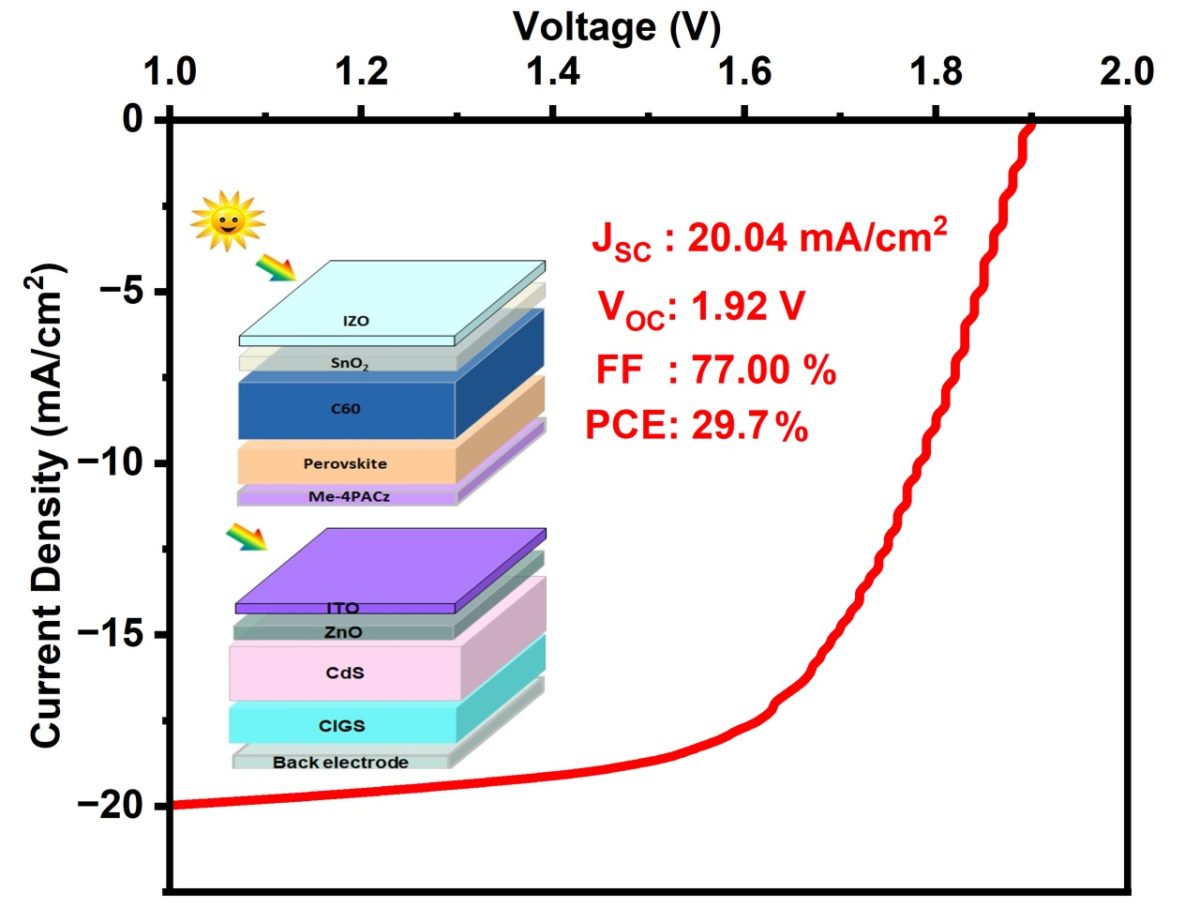From pv magazine Global
Researchers at the Chitkara University in India have designed and simulated a two-terminal, monolithically stacked tandem solar cell based on a bottom cell made of perovskite with an energy bandgap of 1.68 eV. The top cell is based on CIGS, with a bandgap of 1.1 eV.
“Our patented design can significantly suppress the contact recombination and associated reverse saturation current to increase the VOC,” researcher Rahul Pandey told pv magazine.
The researchers conducted a numerical simulation to predict the device’s performance and behavior, using SCAPS-1D solar cell capacitance software, which is a simulation tool for thin-film solar cells developed by the University of Ghent in Belgium.
They designed the bottom cell as having an indium zinc oxide (IZO) transparent conductive oxide film, a tin(IV) oxide (SnO2) buffer layer, a perovskite layer, and a layer of methyl-substituted carbazole (Me-4PACz) as the hole-transport layer. For the top cell, they proposed to utilize indium tin oxide (ITO) substrate, a cadmium sulfide (Cds) layer, and a CIGS absorber.
“In the top cell, the perovskite layer acts as an absorber to absorb the high-energy photons. Similarly, the bottom cell uses the CIGS layer to absorb the low-energy photons,” the scientists said, noting that both cells are connected through an intermediate layer of ITO to provide the current matching for the tandem configuration.
They tested different CIGS absorber layer thicknesses from 0.5 micrometers (μm) to 5 μm and found that there was an increase in current density due to higher photon absorption, up to a 2.3 μm thick absorber layer. They also determined that there is a saturation of current density for the thickness beyond 2.3 μm.
With an optimized absorber thickness of 2.3 μm, the bottom cell showed in the simulation it may reach a power conversion efficiency of 16.26%, an open-circuit voltage of 0.64 V, a short-circuit current of 35.98 mA/cm2, and a fill factor of 70.51%.
“The voltage drop across the tandem solar cell is the sum of the voltage drop across both subcells individually, the scientists said, adding that the top cell delivers less current than the bottom cell in the standalone configuration and acts as a current-limiting cell.
The tandem device top/ bottom cell thickness of 347 nm/2.0 μm showed an efficiency of 29.72%, an open-circuit voltage of 1.92 V, a short-circuit current of 20.04 mA/cm2, and a fill factor of 77%.
The scientists introduced the cell technology in “Perovskite-CIGS Monolithic Tandem Solar Cells with 29.7% Efficiency: A Numerical Study,” which was recently published in Energy Fuels.
“The main limitation of the adopted filtered spectrum approach is that it ignores the interfacial reflection losses and interference effects,” they concluded. “The transfer matrix method (TMM) can be used in the future to calculate a more accurate filtered spectrum.”
This content is protected by copyright and may not be reused. If you want to cooperate with us and would like to reuse some of our content, please contact: editors@pv-magazine.com.









By submitting this form you agree to pv magazine using your data for the purposes of publishing your comment.
Your personal data will only be disclosed or otherwise transmitted to third parties for the purposes of spam filtering or if this is necessary for technical maintenance of the website. Any other transfer to third parties will not take place unless this is justified on the basis of applicable data protection regulations or if pv magazine is legally obliged to do so.
You may revoke this consent at any time with effect for the future, in which case your personal data will be deleted immediately. Otherwise, your data will be deleted if pv magazine has processed your request or the purpose of data storage is fulfilled.
Further information on data privacy can be found in our Data Protection Policy.